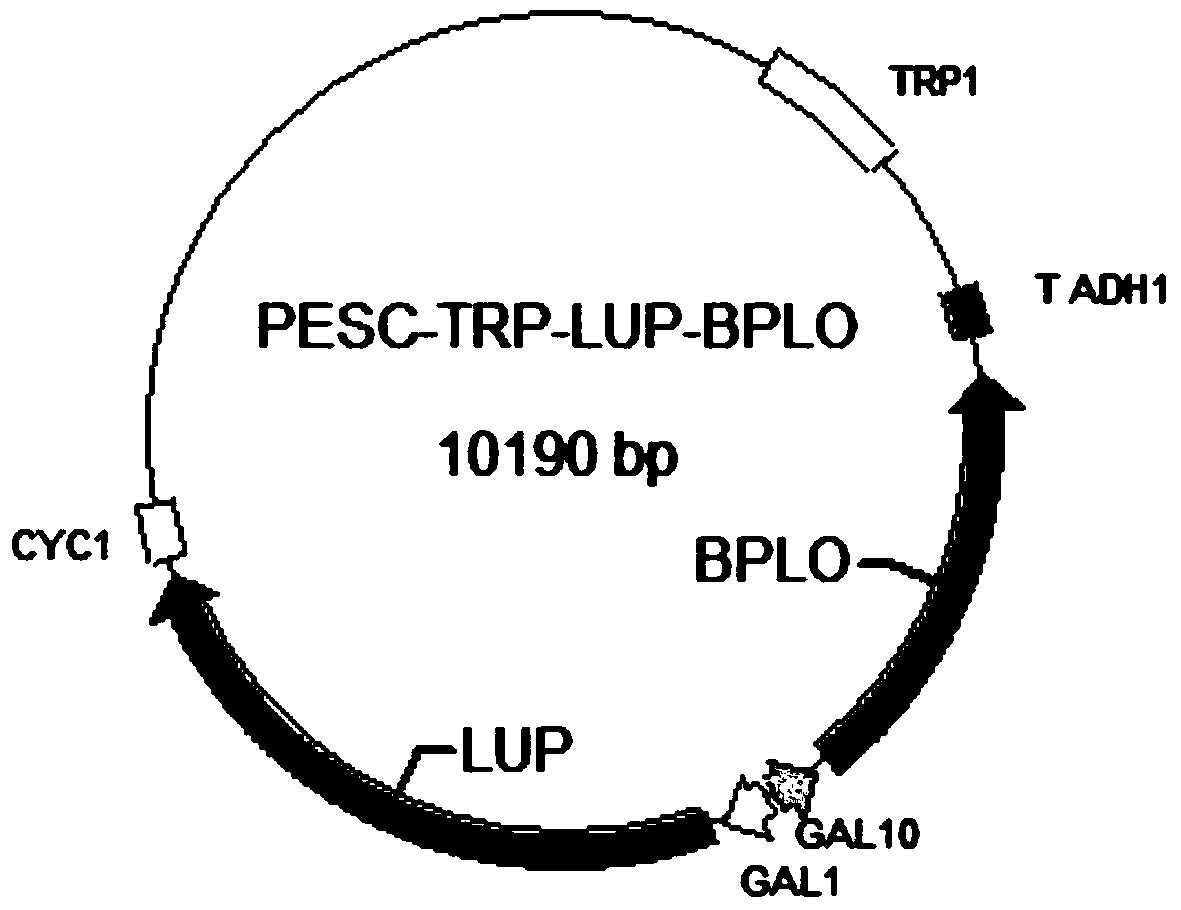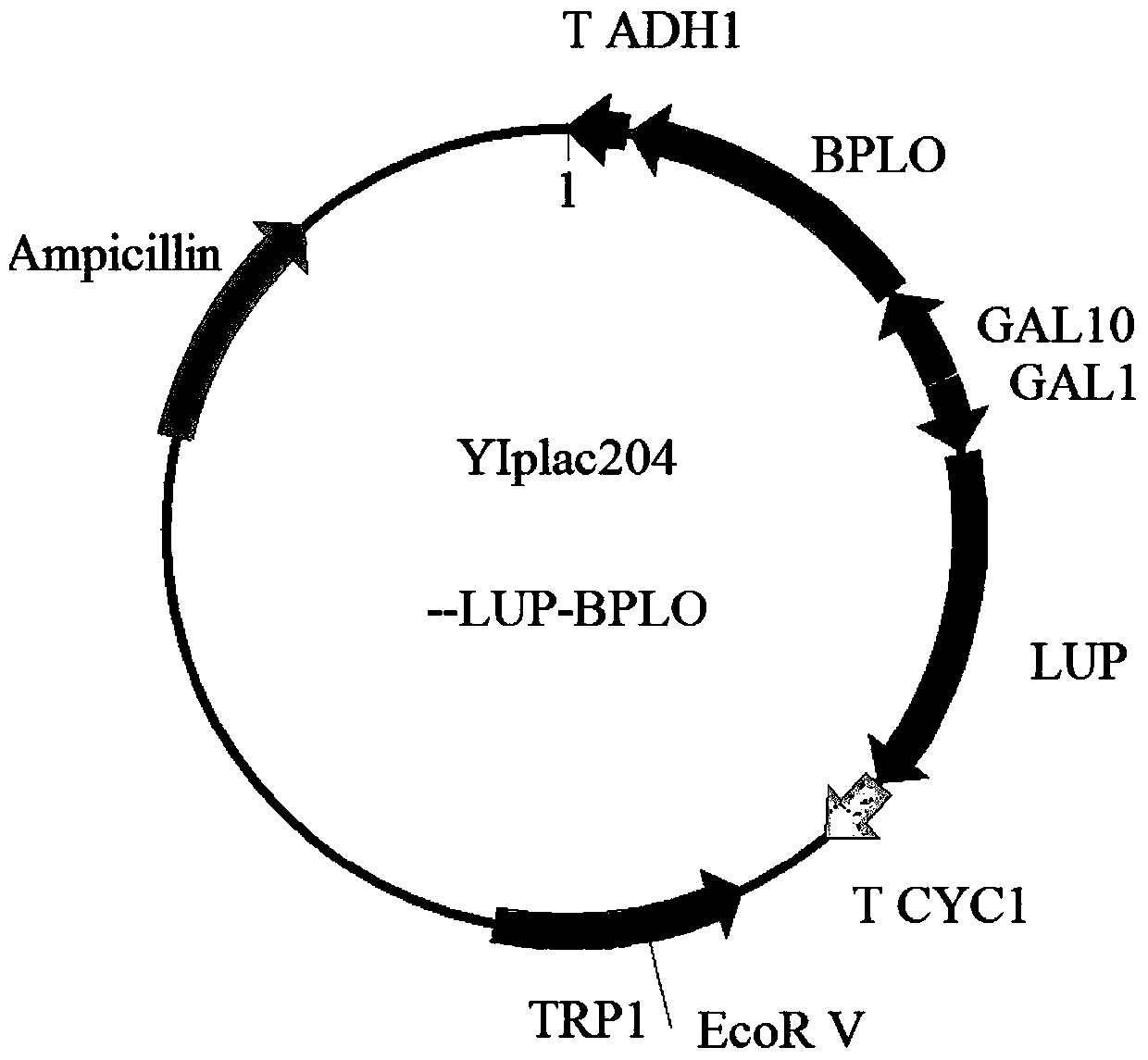A kind of Saccharomyces cerevisiae engineering bacteria for producing betulinic acid and construction method thereof
A technology of Saccharomyces cerevisiae and betulinic acid, applied in the field of genetic modification of microorganisms, can solve problems such as waste of resources
- Summary
- Abstract
- Description
- Claims
- Application Information
AI Technical Summary
Problems solved by technology
Method used
Image
Examples
Embodiment 1
[0034] Example 1 Construction of Saccharomyces cerevisiae strain WAT11-LUP-BPLO producing betulinic acid
[0035] 1. Construction of yeast integration vector YIPlac204-LUP-BPLO
[0036] The LUP gene of Arabidopsis thaliana and the BPLO gene from white birch (Betulaplatyphylla) were respectively connected to the GAL1 and GAL10 promoters of the same PESC-Trp vector to obtain the plasmid PESC-TRP-LUP-BPLO( figure 1). Due to the requirement of the enzyme cleavage site, a base of the EcoRV enzyme cleavage site in the LUP gene was mutated (cytosine in GATATC was mutated into thymine). The specific method is as follows: the plasmid PESC-TRP-LUP-BPLO is used as a template, and two pairs of primers P1 / P4 and P2 / P3 are respectively used for the first round of PCR. Then, the products of the two groups of PCRs in the first round were mixed in equal amounts as templates, and the second round of PCR was performed with the primer pair P3 / P4. The second-round product was subjected to agaro...
Embodiment 2
[0043] Example 2 Construction of Saccharomyces cerevisiae strain W80 with high betulinic acid production
[0044] The Saccharomyces cerevisiae strain WAT11-LUP-BPLO constructed in Example 1 has been able to produce betulinic acid. On this basis, the inventors continued to study and unexpectedly found that when the regulatory factor GAL 80 gene was mutated, the content of the product betulinic acid be greatly improved. According to this finding, the inventors further improved the Saccharomyces cerevisiae strain WAT11-LUP-BPLO by knocking out the GAL 80 gene in the genome of the Saccharomyces cerevisiae strain WAT11-LUP-BPLO by means of homologous recombination. The specific method is as follows:
[0045] 1. Construction of homologous knockout fragments
[0046] Using the pUG6 plasmid (Euroscarf) as a template, use primers P5 / P6 to amplify the loxP-KanMX-loxP selection marker fragment (1724bp), using Saccharomyces cerevisiae WAT11 genomic DNA as a template, use primers P7 / P8 t...
Embodiment 3
[0059] Example 3 Production and extraction of betulinic acid using the Saccharomyces cerevisiae strain of the present invention
[0060] 1. Production and extraction of betulinic acid
[0061] Inoculate the Saccharomyces cerevisiae strain WAT11-LUP-BPLO or W80 obtained in Example 1 or 2 into SD-Trp-liquid medium with 2% glucose as carbon source, place at 30°C, and cultivate at 250rpm / min for 16 hours , and then collected the cells and washed with sterile water and resuspended in SD-Trp-medium with 2% galactose as carbon source to the initial OD 600 The value is 0.8, placed at 30° C., 250 rpm / min for induction culture for 7 days. The yeast culture solution obtained above was acidified (adjusted pH to 2.0 with 2M HCl), and extracted three times with an equal volume of ethyl acetate. The three ethyl acetate phases were combined and dried. After drying, reconstitute with a small amount of ethyl acetate, transfer to a 2ml centrifuge tube, and dry. betulinic acid
[0062] 2. Id...
PUM
 Login to View More
Login to View More Abstract
Description
Claims
Application Information
 Login to View More
Login to View More - R&D
- Intellectual Property
- Life Sciences
- Materials
- Tech Scout
- Unparalleled Data Quality
- Higher Quality Content
- 60% Fewer Hallucinations
Browse by: Latest US Patents, China's latest patents, Technical Efficacy Thesaurus, Application Domain, Technology Topic, Popular Technical Reports.
© 2025 PatSnap. All rights reserved.Legal|Privacy policy|Modern Slavery Act Transparency Statement|Sitemap|About US| Contact US: help@patsnap.com



